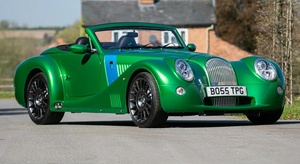
By Tom Suddard and Andy Hollis
After two days with our Hyundai Ioniq 5 N on the Tire Rack One Lap of America Presented by Grassroots Motorsports, we’d learned a lot about the car. We’d realized it wasn’t a big deal to road-trip an EV, and we’d put it shockingly high on the …
Read the rest of the story
Wow !
Hanging with Randy Pobst after day 2? Impressive for an SUV !
Loving these updates! Keep the tech info coming. Can't wait to get my Ioniq 5N on the track this weekend.
Love this. Please keep us updated on progress and experience. Bonus for charging experience reviews.

BA5
HalfDork
5/5/25 3:39 p.m.
Did you have a full size spare or are you going to have to source a new wheel/tire?
Andy actually bought a curbed stock wheel on eBay last week, so we have a full sized (but ugly) spare.
Just finished our first charge stop en route from Hedge Hollow to NCM in Bowling Green. We're back on the road now, so I might as well talk more about charging.
The Hyundai is based on an 800V architecture, which is one reason it can charge so quickly. Most EVs are based on a 400V system. Higher voltage means lower amperage to hit the same amount of power, which means less heat, smaller wiring, etc.
This becomes a problem when visiting Superchargers: All Teslas aside from the Cybertrucks are 400V, so the vast majority of their chargers are, too. This means the Hyundai can only charge at about half of its theoretical max rate. (to turn 400V into 800V, it uses its rear motor as a converter).
So, that's why this charge stop was slower than ideal.

In reply to Tom Suddard :
That's pretty good though all told... I don't see anywhere what year/model of Ioniq 5 you guys have, but from my research on BEVs when I was looking at donors for the DMC's conversion that stop looks like it would have gotten a standard-range model to over 80% charge and a LR version to over 60%, and going by at least the predicted ranges for the car around 200 miles of range. And given gas around here is at about $3/gallon for regular you'd need a vehicle that got nearly 40mpg to go the same distance for the price you paid for the electricity.
This is seriously freaking cool. Loving the updates. My lust for the N is strong. As is my desire to do one lap. Somewhere, there's an interview that aired on "TNN" with Brock Sr, my brother and me from Road Atlanta in 2003(?) We watched a guy blow up his crx with nitrous, so we bought his nitrous kit to blow up our crx with.

Tom Suddard said:
Just finished our first charge stop en route from Hedge Hollow to NCM in Bowling Green. We're back on the road now, so I might as well talk more about charging.
The Hyundai is based on an 800V architecture, which is one reason it can charge so quickly. Most EVs are based on a 400V system. Higher voltage means lower amperage to hit the same amount of power, which means less heat, smaller wiring, etc.
This becomes a problem when visiting Superchargers: All Teslas aside from the Cybertrucks are 400V, so the vast majority of their chargers are, too. This means the Hyundai can only charge at about half of its theoretical max rate. (to turn 400V into 800V, it uses its rear motor as a converter).
So, that's why this charge stop was slower than ideal.
Short thread derail. We have a 2023 Ioniq 6 which also has 800V architecture. We're also still within the 2 years free charging with EA. What I don't understand is why, when we plug into a 350W charger and it's optimal charging conditions (~85 degrees out, ~20% SOC) we always seem to max out at ~135KW charging speed. Often we are the ONLY car charging yet we don't get even close to the full charging speed.
Just finished a stint driving--we hit an EA charger for a quick charge, but didn't find any edible dinner there, so we high-tailed it to a GM energy/EVgo charger at a Flying J. It's really tough to get fast food, carry it back to the car, and wolf it down before the charge is complete, and we're feeling extremely rushed. But we need to keep making time on this 600 mile transit.
Charge 1:

Charge 2:


JG Pasterjak
Tech Editor & Production Manager
5/5/25 8:41 p.m.
dyintorace said:
Tom Suddard said:
Just finished our first charge stop en route from Hedge Hollow to NCM in Bowling Green. We're back on the road now, so I might as well talk more about charging.
The Hyundai is based on an 800V architecture, which is one reason it can charge so quickly. Most EVs are based on a 400V system. Higher voltage means lower amperage to hit the same amount of power, which means less heat, smaller wiring, etc.
This becomes a problem when visiting Superchargers: All Teslas aside from the Cybertrucks are 400V, so the vast majority of their chargers are, too. This means the Hyundai can only charge at about half of its theoretical max rate. (to turn 400V into 800V, it uses its rear motor as a converter).
So, that's why this charge stop was slower than ideal.
Short thread derail. We have a 2023 Ioniq 6 which also has 800V architecture. We're also still within the 2 years free charging with EA. What I don't understand is why, when we plug into a 350W charger and it's optimal charging conditions (~85 degrees out, ~20% SOC) we always seem to max out at ~135KW charging speed. Often we are the ONLY car charging yet we don't get even close to the full charging speed.
This is because EA kind of sucks. We've never seen beyond 160 at our local EA, which is also marked as a 350kw outlet but has never delivered that. The only EA station I've ever gotten that much out of was a brand new install.

dyintorace said:
Tom Suddard said:
Just finished our first charge stop en route from Hedge Hollow to NCM in Bowling Green. We're back on the road now, so I might as well talk more about charging.
The Hyundai is based on an 800V architecture, which is one reason it can charge so quickly. Most EVs are based on a 400V system. Higher voltage means lower amperage to hit the same amount of power, which means less heat, smaller wiring, etc.
This becomes a problem when visiting Superchargers: All Teslas aside from the Cybertrucks are 400V, so the vast majority of their chargers are, too. This means the Hyundai can only charge at about half of its theoretical max rate. (to turn 400V into 800V, it uses its rear motor as a converter).
So, that's why this charge stop was slower than ideal.
Short thread derail. We have a 2023 Ioniq 6 which also has 800V architecture. We're also still within the 2 years free charging with EA. What I don't understand is why, when we plug into a 350W charger and it's optimal charging conditions (~85 degrees out, ~20% SOC) we always seem to max out at ~135KW charging speed. Often we are the ONLY car charging yet we don't get even close to the full charging speed.
This car will tell us something like "charging speed limited by charger." Do you get anything similar? It's probably a broken/slow charger.
You are sure it's an 800v charger, right? This car seems to be current limited to somewhere around roughly 325 amps, so on a 400v charger that's about what you should get.
Love the Home Depot special. Need all the charge you can get on track!
Interested in hearing about tracks that don't have a 240V outlet in the paddock...
In reply to hunter47 :
Most tracks have 240V in the paddock (RV power). When they don't, we'll just charge on the way in.
Wow, that thing is pricey to refuel. $0.55 per kWh is like paying $6.90 gallon in a 30mpg vehicle (if I'm correct that the I5N battery is 84kWh and that's good for 200 miles).
30% battery usage for a single session of OneLap action seems like a lot. I think that means a typical 20-30 minute track day session would use like 60-80% of the battery. If you were at TrackNight and you used 60% of the battery in the first session, how much charge could you get back in the 60 minute gap before session 2?
And after two more charges, we made it to our hotel just after 1:00 a.m. Somehow, we had a perfect string of working 800V chargers meaning 15-20 minute sessions for the entire transit. Sweet!


In reply to CrashDummy :
We're prioritizing speed vs. price when picking chargers--if we weren't looking for the fastest ones, we'd be paying closer to $.30-$.40/kWh (like we did at that first Tesla charger).
We could charge to full between the sessions in your hypothetical.
At the end of this, may we have a breakdown that shows tire cost as well?
Tire cost is easy: we're limited to one set of tires for the entire event, and our Michelin Pilot Sport S 5s are $533 each from Tire Rack. https://www.tirerack.com/tires/tires.jsp?tireMake=Michelin&tireModel=Pilot+Sport+S+5&sidewall=Blackwall&partnum=735YR1PSS5XLND0&tab=Sizes

Tom Suddard said:
dyintorace said:
Tom Suddard said:
Just finished our first charge stop en route from Hedge Hollow to NCM in Bowling Green. We're back on the road now, so I might as well talk more about charging.
The Hyundai is based on an 800V architecture, which is one reason it can charge so quickly. Most EVs are based on a 400V system. Higher voltage means lower amperage to hit the same amount of power, which means less heat, smaller wiring, etc.
This becomes a problem when visiting Superchargers: All Teslas aside from the Cybertrucks are 400V, so the vast majority of their chargers are, too. This means the Hyundai can only charge at about half of its theoretical max rate. (to turn 400V into 800V, it uses its rear motor as a converter).
So, that's why this charge stop was slower than ideal.
Short thread derail. We have a 2023 Ioniq 6 which also has 800V architecture. We're also still within the 2 years free charging with EA. What I don't understand is why, when we plug into a 350W charger and it's optimal charging conditions (~85 degrees out, ~20% SOC) we always seem to max out at ~135KW charging speed. Often we are the ONLY car charging yet we don't get even close to the full charging speed.
This car will tell us something like "charging speed limited by charger." Do you get anything similar? It's probably a broken/slow charger.
You are sure it's an 800v charger, right? This car seems to be current limited to somewhere around roughly 325 amps, so on a 400v charger that's about what you should get.
I guess I am assuming they are 800v chargers but maybe they're only 400v? I'll have to check the EA app next time we charge to see if it defines the voltage of each charger. I've never checked.
Tom Suddard said:
Tire cost is easy: we're limited to one set of tires for the entire event, and our Michelin Pilot Sport S 5s are $533 each from Tire Rack. https://www.tirerack.com/tires/tires.jsp?tireMake=Michelin&tireModel=Pilot+Sport+S+5&sidewall=Blackwall&partnum=735YR1PSS5XLND0&tab=Sizes
Jebus. That's a lot of lettuce for a tire.









































